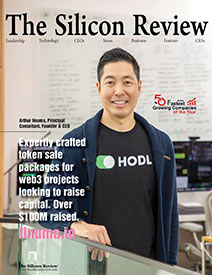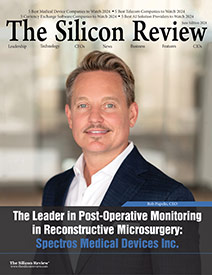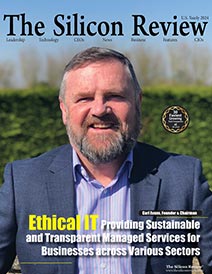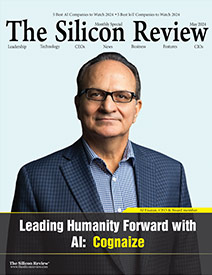30 Best Small Companies to Watch 2020
Semantic Arts future-proofs the enterprise with data-centric transformation programs
The Silicon Review
![]()
99% of all enterprises shoot themselves in the foot every time they implement a new information system. The prevailing mindset, the “application-centric” mindset, guarantees that each new system introduces yet another incompatible data model into the firms datascape. It doesn’t matter whether the firm is building a custom application, whether they are buying an application package or whether they are renting Software as a Service. It doesn’t matter whether the methodology is waterfall or agile. Solving business problems by implementing applications is what creates the dreaded silos.
The compounding problem is these application systems each have their own completely idiosyncratic data models. In addition to being arbitrarily different, almost every application is at least an order of magnitude more complex than it needs to be. The net result is, after a few decades, you have hundreds or thousands of applications implemented, each with their own data model. You spend most of your IT budget on systems integration, without really achieving it.
Semantic Arts discovered it’s possible to build an elegant core model of even the most complex enterprise in a limited amount of time (typically less than six months) and with a limited amount of complexity (typically fewer than 500 concepts (classes + properties). When well implemented, the said model can be extended and specialized in handling specific requirements of subdomains or departments while still staying aligned with the enterprise core as business continues to grow. The model can be directly populated with data from the legacy systems, and queries can be federated over the legacy systems through the core model. Such a model in the short term can provide a simple integration platform that not only integrates legacy systems but also allows the integration of unstructured and external data.
Semantic Arts is a professional services firm—they do not sell software or hardware—therefore, the company is completely objective and can bring business outcome thinking and considerable experience to every engagement.
In conversation with Dave McComb, Co-founder and CEO of Semantic Arts
Q. Can you tell us about your services in brief?
Semantic Arts delivers a single offering: we help guide clients who are committed to transitioning to a data-centric future by implementing this capability through our consulting services. Some may come to the need to do this through their digital transformation efforts, which more and more are discovering to be far harder than it should be because they are trying to build on a foundation of brittle complexity inherently in relational and legacy data structures. Some come to it through big data, AI, and ML, when they find that they are spending most of their time and effort wrangling data that should already be organized. And some have come to it from first principles, as we did. Our first engagement is a combination of what we call “think big / start small” implementation methodology for most clients. We discovered the need to do both in parallel. To do only the think big part (as we did for more than a decade) creates beautiful models that do not get implemented. To only start small (as every agile project does these days) almost guarantees the furtherance of silos. By doing the two in parallel, we can show how the core model (the think big part) guides each “small” (incremental) project to conform to the core.
After that first project, most clients re-engaged us for many more projects, which either tackle additional domain areas, begin building out the information architecture needed to take maximum advantage of this approach or establish training and governance to make this the new normal.
Q. Huge amount of data is created every second from sources like online transactions, social media, or customer data. Do you think the existing ways of managing data is enough for exponentially bigger data quantity?
Well, it has to be managed in layers, it’s obvious that we will have even more data, and the Internet of Things is going to swamp the existing data completely. But the traditional approach of just copying all of the data and moving it around to a big data platform so that people can do analytics is not going to scale to that. There’s more data than what the systems can process over. What will happen instead is there’s going to be a lot more edge computing where the big data, IoT, and the clickstream analysis will stay. It’s going to be abstracted, and the essential differences are going to come into an analytic framework.
Q. With the situation today due to coronavirus, everything is going online. How are you helping your clients adjust to the new normal?
One of the big things that people are doing right now is called digital transformation, and I think that the coronavirus pandemic has only accelerated the process. But as a lot of authors have pointed out, digital transformation projects have about a 70 percent failure rate, and they are incredibly expensive. People are just trying to use brute force to change their existing procedures into a fully digital-enabled, stymied sheer scale and complexity. So, our approach is to find the elegant, simple model that represents the core of your business and use that to fuel your digital transformation. We’re guiding our clients in implementing this capability to ease information findability, accessibility, interoperability, and re-usability.
Q. Normally reliable and high-quality services come at an expensive price tag. How do you manage to keep your services affordable?
We primarily work with very large firms and have small, agile teams, so compared to a typical application implementation project, these are a fraction of. Our services are very affordable and barely noticeable, but in the longer term, the data-centric approach is going to move into mid-market, where it will become a platform play.
Meet the leader behind the success of Semantic Arts
Dave McComb is the President and Co-founder of Semantic Arts. He and his team help organizations uncover the meaning in the data from their information systems. Dave is also the author of “The Data-Centric Revolution”, “Software Wasteland” and “Semantics in Business Systems”. For 20 years, Semantic Arts has helped firms of all sizes in this endeavor, including Proctor & Gamble, Goldman Sachs, Schneider-Electric, Lexis Nexis, Dun & Bradstreet, and Morgan Stanley. Prior to Semantic Arts, Dave co-founded Velocity Healthcare, where he developed and patented the first fully model driven architecture. Prior to that, he was a part of the problem.









